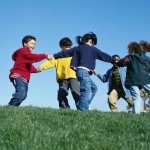Activity of Friends and After-School Activity in Kids
Thursday, May 31, 2012 Here is a piece of research, where one could have probably guessed the results – if your close friends are active after school, so are you!
Here is a piece of research, where one could have probably guessed the results – if your close friends are active after school, so are you!
Thus, according to a paper by Sabina Gesell and colleagues from Vanderbilt University School of Medicine, Nashville, Tennessee, published in PEDIATRICS, a social network analysis in 83 public school students participating in 2 structured aftercare programs found that while children did not form or dissolve friendships based on physical activity levels, existing friendships heavily influenced their level of physical activity.
In fact, the strongest predictor of the amount of time children spent in moderate-to-vigorous activity in the afterschool hours was the activity level of their immediate friends.
It appears that children consistently made adjustments to their activity levels of 10% or more to emulate the activity levels of their peers.
This effect was largely independent of age, sex or obesity status.
“Children did not select friends based on activity level. Active children did not have more (or fewer) friends than nonactive children, nor were they more (or less) likely to be chosen as friends. Friendships were more likely to be based on homophily in age, school, gender, and race.”
Thus, the authors conclude that friendship ties play a critical role in setting physical activity patterns in children as young as 5 to 12 years.
From an intervention perspective (especially in light of yesterday’s post on the Active Health Kids Report Card), it is very likely that children’s activity levels can be increased, decreased, or stabilized depending on the activity level of their immediate social network.
“Given the opportunity to either change activity level to match that of their friends, or keep activity level constant, children were 6 times more likely to adjust their activity level. Children became either more active or more sedentary as they emulated the behaviors of those in their immediate network.”
Thus, if you could just get a couple of kids within a network to be more active after school, their best friends will likely follow.
Or, as the authors suggest:
“An intervention that embeds inactive children with active peers may improve activity levels across the entire social network. Such a strategy could startwith a group of very active children and implement a “rolling enrollment” of inactive children into the group. It would be critical that these inactive children form friendships with the active children for them to become more active themselves.”
Unfortunately, getting kids to become friends is no easy task, so this may be easier said than done.
AMS
Edmonton, Alberta
![]() Gesell SB, Tesdahl E, & Ruchman E (2012). The Distribution of Physical Activity in an After-school Friendship Network. Pediatrics PMID: 22641755
Gesell SB, Tesdahl E, & Ruchman E (2012). The Distribution of Physical Activity in an After-school Friendship Network. Pediatrics PMID: 22641755
.
.


